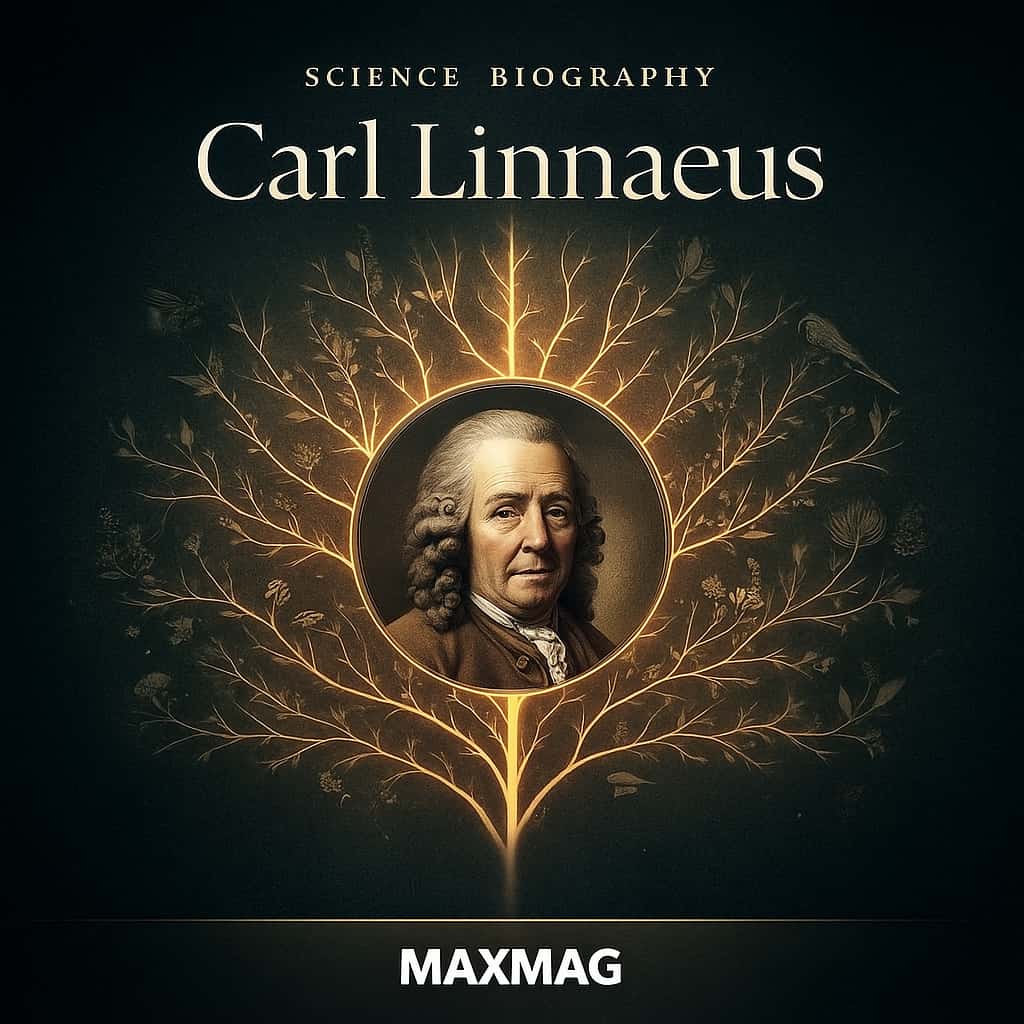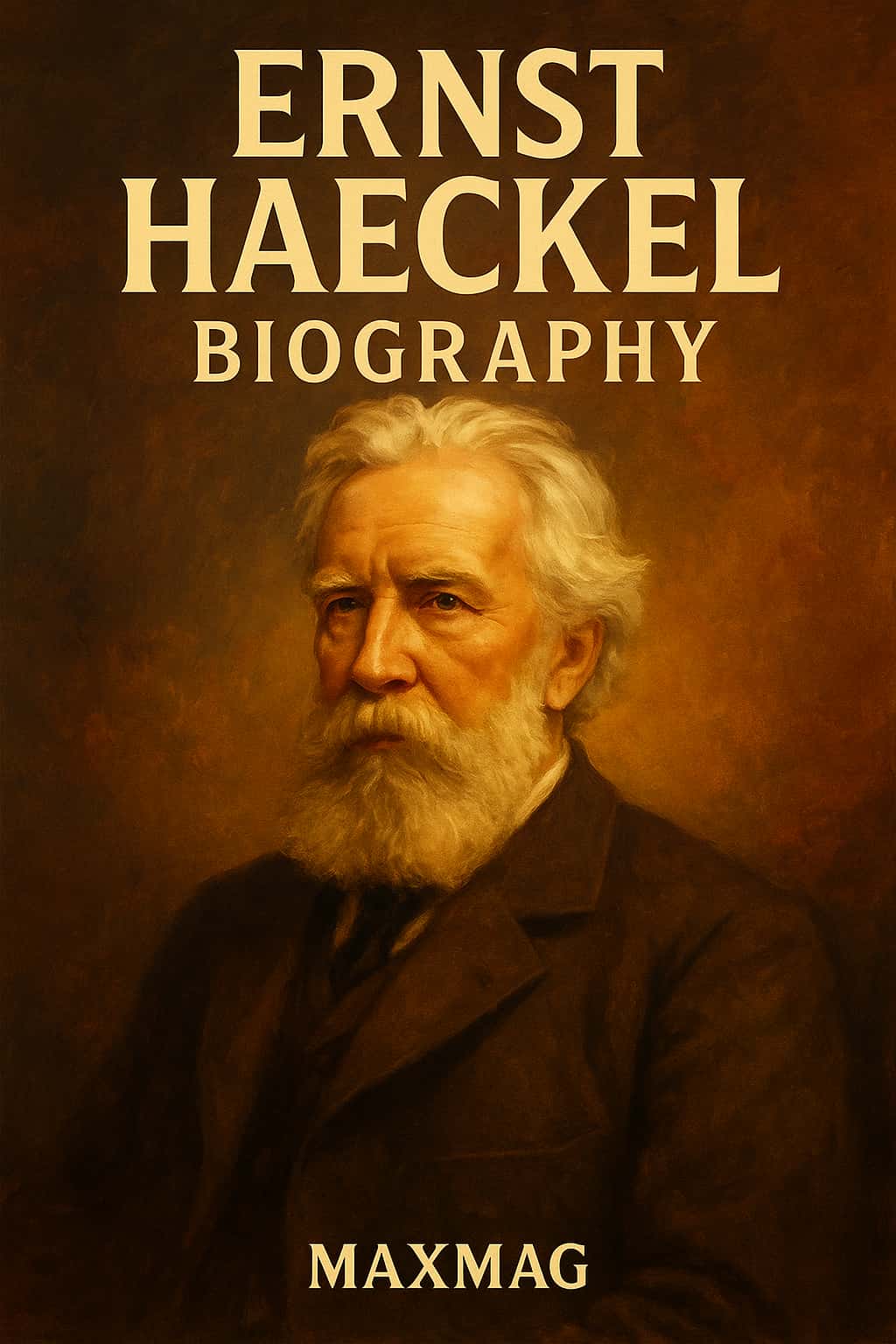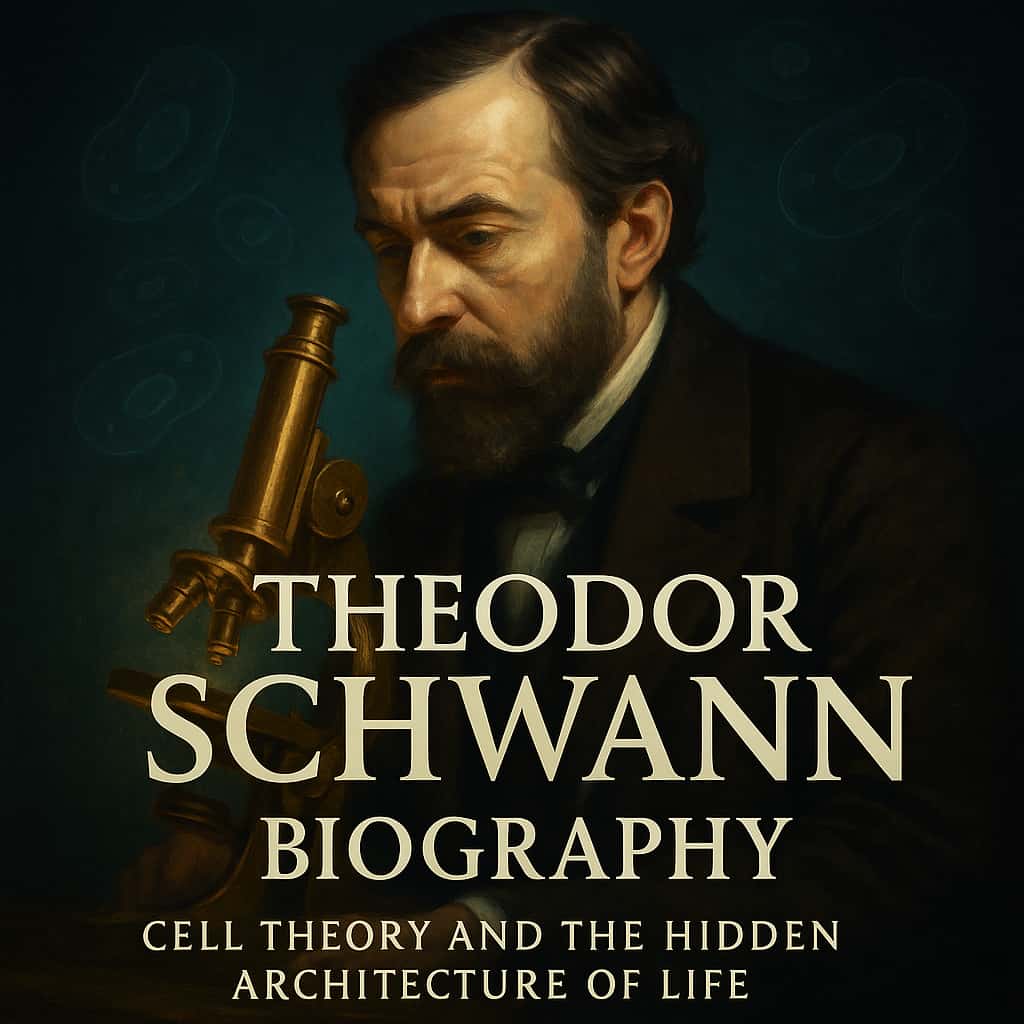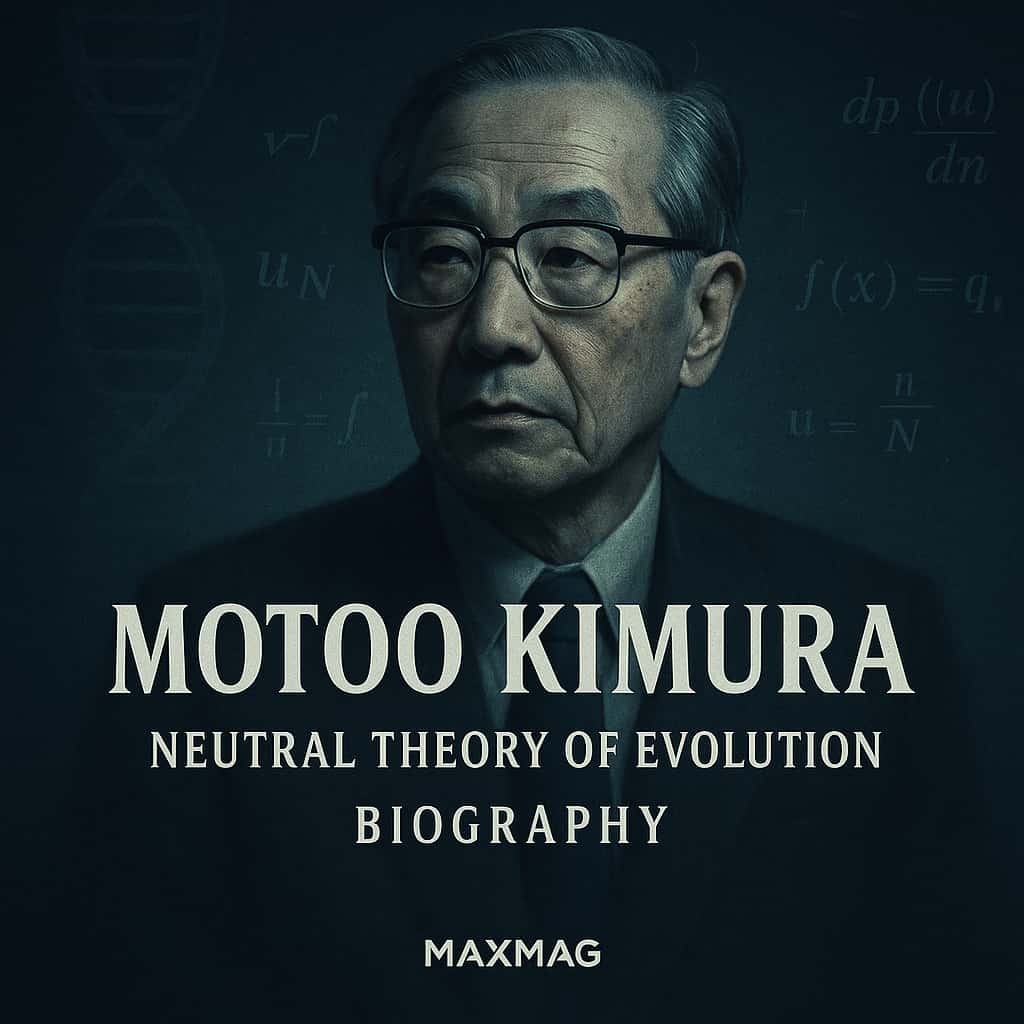
On an overcast day in 1968, in a modest office in Mishima, Japan, a reserved population geneticist sketched equations that would ignite one of the most intense debates in modern biology. Those equations led to the neutral theory of molecular evolution – the idea that most changes in DNA are neither good nor bad, but simply drift through populations by chance. This Motoo Kimura biography traces how a quiet mathematician of evolution came to challenge the central story scientists told about how life changes over time.
The phrase “neutral theory” sounds abstract, almost bloodless. Yet behind it lies a deeply human drama: a young man recovering from illness who taught himself mathematics; a wartime student navigating Japan’s upheavals; a researcher who crossed the Pacific to learn from the giants of population genetics; and an older scientist facing illness while watching his once-controversial ideas seep into the foundations of genomics. To understand the Motoo Kimura biography is to understand how twentieth-century science learned to live with chance.
Kimura’s life spanned from 1924 to 1994, a period when biology rushed from field notebooks and microscopes to protein gels and DNA sequencers. In that span, evolutionary theory had to adapt to an explosion of molecular data that did not always match Darwinian expectations. This Motoo Kimura biography follows how one population genetics pioneer used probability, patience and stubbornness to reinterpret what those data meant for evolution itself.
Motoo Kimura biography at a glance
- Who: Motoo Kimura, Japanese evolutionary biologist and population genetics pioneer.
- Era: Born in 1924 in Okazaki, Japan; active during the mid- to late twentieth-century science boom; died in 1994.
- Headline contribution: Originator of the neutral theory of molecular evolution, which argues that most molecular genetic changes are selectively neutral.
- Why he matters today: His work underpins modern views of genetic drift, molecular clocks and how we interpret genome data in evolutionary biology and medicine.
Early Life and Education of Motoo Kimura
Childhood in Okazaki: plants, illness and numbers
Any honest Motoo Kimura biography has to begin in Okazaki, a regional city in Aichi Prefecture where he was born on 13 November 1924. As the first son of a businessman, Kimura was not necessarily destined for science, but he developed a fascination with plants that would never quite leave him. He collected specimens, studied their shapes and textures, and found in their patterns something that felt both orderly and mysterious.
A serious bout of food poisoning kept him out of school for months. Confined at home, he turned to mathematics as a kind of private refuge, teaching himself geometry and more advanced topics from borrowed books. It is a striking detail in the Motoo Kimura biography: a future architect of probability models learning to think abstractly while physically weakened, realising that equations could capture patterns just as cleanly as botanical drawings.
When he finally returned to a selective high school in nearby Nagoya, Kimura gravitated toward plant morphology and cytology, disciplines that examine the structure and chromosomes of plants. It was there that he first combined his two obsessions: the tangible world of lily chromosomes under a microscope, and the austere symbols of mathematics. That mix – concrete biological questions tackled with mathematical tools – would define his role as a population genetics pioneer.
War, Kyoto Imperial University and a narrow escape
Kimura’s university years unfolded amid the turbulence of the Second World War. On the advice of the renowned geneticist Hitoshi Kihara, he entered the botany programme at Kyoto Imperial University rather than a more agriculture-oriented course that might have pushed him closer to military service. The choice was partly pragmatic – staying in the Faculty of Science conferred some protection – but it also placed him in one of Japan’s strongest genetics environments.
In post-war Kyoto, with cities still scarred and food still scarce, Kimura immersed himself in plant cytogenetics: how chromosomes behave, how foreign chromosomes can be introduced into plants, and how hybridisation works at a cellular level. These were hands-on, empirical projects, very different from the abstract diffusion equations that would later dominate any Motoo Kimura biography. Yet they gave him an intuitive sense of how messy genetic reality can be – a sense that would later make his theoretical work feel grounded rather than purely formal.
Discovering population genetics
After the war, Kimura joined the new National Institute of Genetics in Mishima, a small city within sight of Mount Fuji. The institute was young, ambitious and hungry for ideas from abroad. There, Kimura encountered the writings of Ronald Fisher, J. B. S. Haldane and Sewall Wright – the architects of the mathematical “modern synthesis” of evolution. For the first time, he saw that the kinds of probability calculations he enjoyed could be applied directly to questions about how genes spread in populations.
In the early 1950s he began publishing highly technical papers on population genetics, including his influential “stepping stone” model of how genes move through continuous landscapes rather than isolated islands. These early papers announced Kimura as a population genetics pioneer comfortable with difficult mathematics: an unusual figure in Japanese biology at the time, and a sign that the Motoo Kimura biography would be inseparable from the history of evolutionary theory itself.
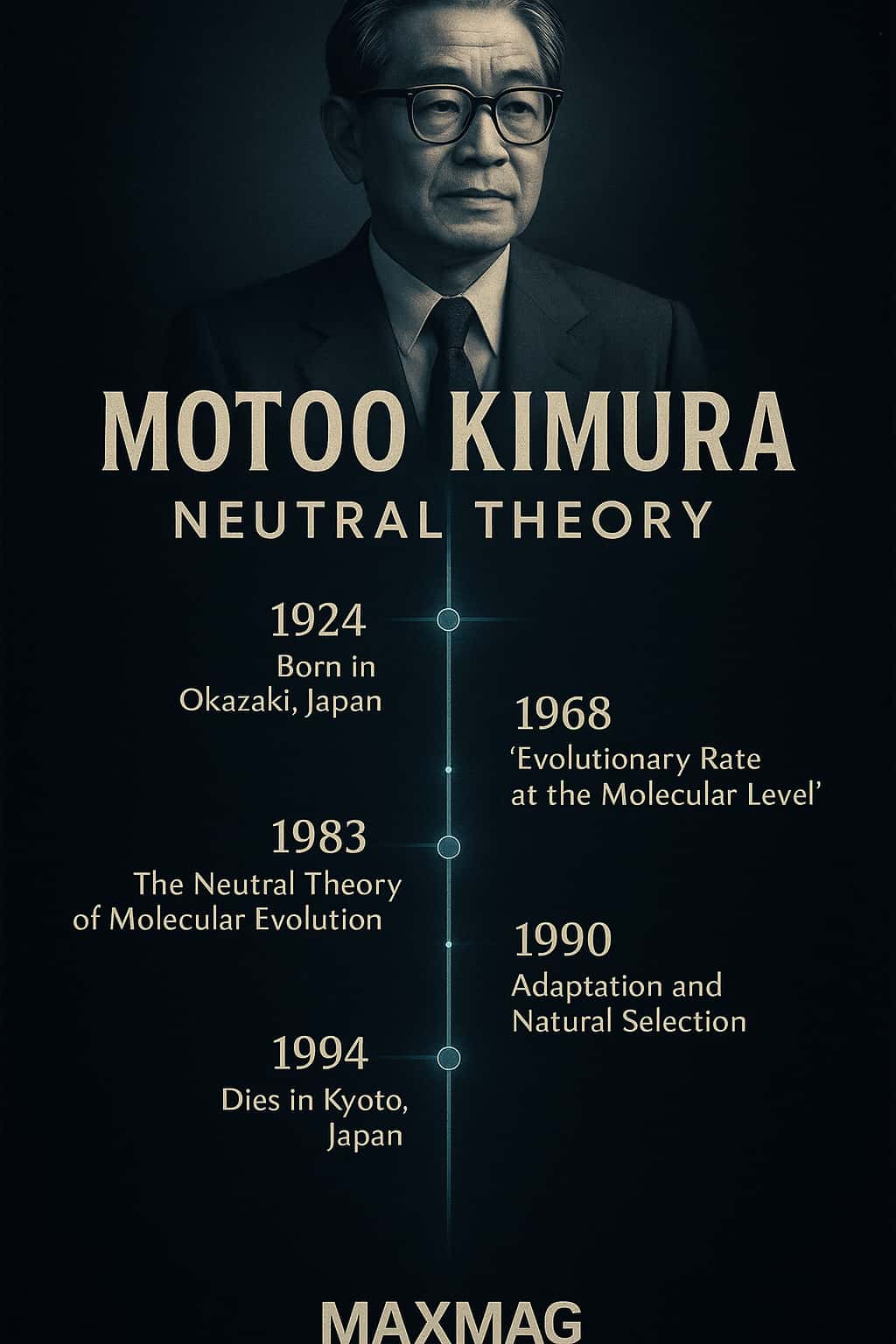
Motoo Kimura biography and the birth of the neutral theory
Motoo Kimura biography as a Japanese student in the American heartland
In 1953, Kimura travelled to the United States to study with Jay Lush at Iowa State College, following contacts made through the Atomic Bomb Casualty Commission. He found the atmosphere stiflingly applied, however, and soon moved to the University of Wisconsin–Madison to work with James F. Crow, one of the leading theoretical population geneticists. There, in a bustling one-room lab full of students and visiting scholars, Kimura came into direct contact with Sewall Wright and other giants of the field.
Wisconsin gave him both community and challenge. He refined his use of diffusion equations – tools from statistical physics that describe how probabilities spread – and developed general models of genetic drift that could include selection, mutation and migration. His PhD, completed in 1956, was titled “Stochastic Processes in Population Genetics”, a dry-sounding document that in retrospect sits near the centre of any serious Motoo Kimura biography.
Today, the history of population genetics at the University of Wisconsin highlights Kimura’s role in shifting the field towards more rigorous stochastic models. The young Japanese mathematician of evolution had found his intellectual home – even if, after graduation, he would carry those tools back to Mishima, where he spent the rest of his scientific life.
From protein gels to a troubling conclusion
By the 1960s, a revolution was underway. New techniques, such as protein electrophoresis, allowed biologists to visualise variation in enzymes between individuals and species. The results were startling: there was far more molecular variation than most Darwinian models predicted. If natural selection was constantly weeding out less fit variants, why were so many different forms of the same proteins persisting?
Kimura pored over these data. For a population geneticist steeped in mathematical rigour, they posed a puzzle, almost a contradiction. The rates of amino-acid change inferred from molecular data seemed too high for each substitution to have been driven by positive natural selection. The equations stubbornly implied that if all those differences had been shaped by selection, populations would have carried an impossibly heavy “genetic load” of deleterious mutations.
In 1968, he offered an alternative reading. In a landmark paper, Kimura argued that most of these changes were effectively neutral – they neither increased nor decreased an organism’s fitness. Instead of being sculpted by selection, they wandered randomly in frequency until sometimes, by chance, they became fixed in the population. This was the birth of the neutral theory of molecular evolution, the turning point around which any Motoo Kimura biography must pivot.
Writing The Neutral Theory of Molecular Evolution in the Motoo Kimura biography
Kimura was not content with a single article. Over the next decade and a half, he published a stream of papers expanding and testing his ideas, culminating in his 1983 monograph, The Neutral Theory of Molecular Evolution. The book pulled together mathematical derivations, empirical evidence and responses to criticism into a single, dense volume that quickly became a touchstone for evolutionary genetics history.
The neutral theory, in simple terms, says this: imagine evolution not as a constant march of improvement, but as a crowded lottery. Most tickets – most mutations – are either so bad they are quickly discarded, or so similar in payoff that it hardly matters which one wins. The winners are chosen not by merit but by random draws, generation after generation. The Motoo Kimura biography is, in that sense, the story of a scientist who insisted that chance has a seat at the evolutionary table.
Key Works and Major Contributions of Motoo Kimura
Diffusion equations and the architecture of drift
Long before the neutral theory, Kimura had already reshaped population genetics by introducing diffusion equations into the field. Working from earlier hints by Wright, he formalised how allele frequencies move under the combined influence of random sampling, mutation and selection. These equations allowed researchers to calculate the probability that a new mutation would eventually become fixed, or how long that process might take.
For non-specialists, diffusion theory can sound forbiddingly abstract. But its essence is simple: instead of tracking each individual, one tracks the “cloud” of possibilities for a gene’s frequency, much as physicists track the spread of particles in a gas. In the Motoo Kimura biography, these methods are central because they provided the mathematical backbone for his later claim that most molecular evolution is governed by neutral drift.
Infinite alleles, infinite sites and the power of abstraction
Kimura also developed several idealised mutation models – the “infinite alleles”, “infinite sites” and “stepwise” models. Each stripped away biological detail to focus on statistical structure. The infinite alleles model, for instance, assumes that every new mutation creates a brand-new variant never seen before, a useful simplification when thinking about rare variants in large populations.
These models may sound esoteric, but they underpin many of the tests and estimators used today to study genetic diversity. They helped bridge the gap between evolutionary genetics history and modern computational genomics, giving researchers tools to compare data from different species and time periods. In the broader Motoo Kimura biography, they stand as a reminder that his legacy is not just one theory, but an entire toolkit.
Neutral theory meets real genomes
Crucially, Kimura’s work on neutral theory was never entirely detached from evidence. He and his collaborators compared rates of change in different parts of proteins, noting that regions with fewer functional constraints – such as tails or surface loops – tended to evolve faster, just as neutral theory predicted. Later, as DNA sequence data accumulated, neutral models became a standard “null hypothesis” against which adaptive stories had to be tested.
Today, when evolutionary biologists decide whether a stretch of DNA is under selection, they very often start by asking whether it deviates from a neutral expectation. That habit – treating neutral evolution as the default – is perhaps the most far-reaching part of the Motoo Kimura legacy.
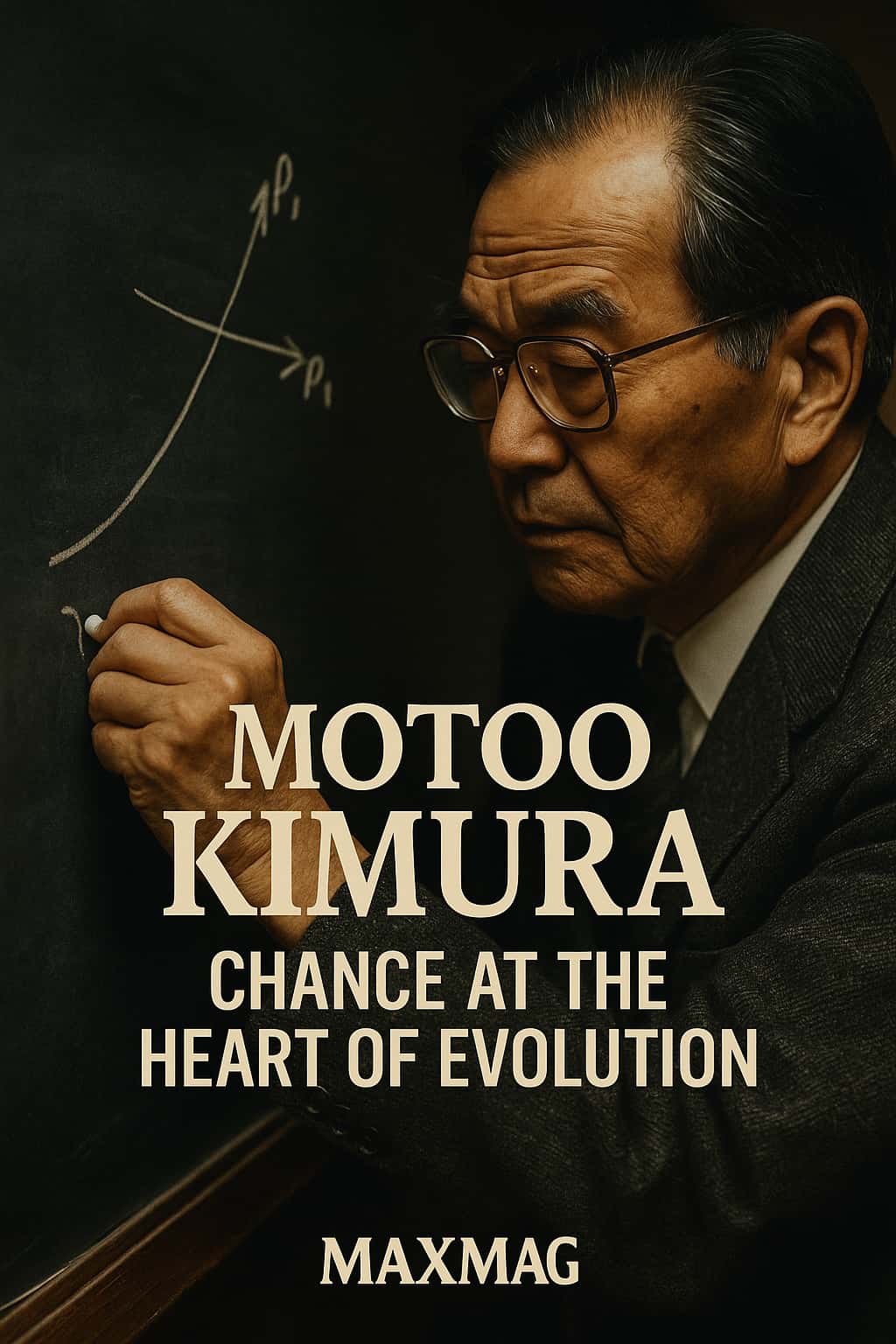
Methods, Collaborations and Working Style in the Motoo Kimura biography
The Mishima institute: quiet, intense and competitive
After Wisconsin, Kimura returned to the National Institute of Genetics in Mishima and stayed there for the rest of his career. Colleagues remember the institute as an odd mix of tranquillity and intellectual rivalry: cherry trees outside, chalk dust and sharp arguments inside. Kimura reportedly preferred working early in the day, filling notebooks with compact equations, then pacing the corridors while thinking through the consequences.
Accounts from those who knew him describe an eccentric but generous mentor, sometimes brusque, sometimes playful, quick to critique sloppy reasoning but equally quick to encourage bold ideas. In the more intimate corners of the Motoo Kimura biography, we see a man driven by curiosity more than careerism, fiercely protective of his theoretical standards, and yet quietly delighted when younger researchers extended or challenged his work.
Partnerships with James Crow and Tomoko Ohta
Two names recur throughout any serious Motoo Kimura biography: James F. Crow and Tomoko Ohta. Crow, his PhD adviser, remained a close friend and intellectual sparring partner. Their letters and joint papers chart the development of neutral theory and other ideas in real time, revealing how often Kimura revised his arguments in response to criticism.
Ohta, a younger Japanese geneticist, worked closely with Kimura on what became known as the “nearly neutral” theory – the idea that many mutations are not strictly neutral but only very slightly harmful or beneficial, with their fate depending on population size. Together, they expanded the neutral framework to encompass a richer range of molecular evolution scenarios, ensuring that the Motoo Kimura legacy would not be frozen in its original, stark form.
Controversies, Criticism and Misconceptions
Panselectionism versus neutralism
When Kimura first proposed the neutral theory, many evolutionary biologists reacted with suspicion, even hostility. The mainstream view – sometimes dubbed “panselectionism” – assumed that most features of organisms were shaped by natural selection; genetic drift was acknowledged but seen as a sideshow. To some critics, neutral theory sounded like an attempt to dethrone Darwin.
Kimura pushed back. He stressed that his claims were explicitly about molecular evolution: changes in DNA and proteins, not necessarily about visible traits like beaks or limbs. One could fully accept natural selection as the main sculptor of phenotypes, he argued, while still recognising that most changes at the molecular level might be evolutionary background noise. Much of the Motoo Kimura biography as a public figure consists of this patient clarification.
“Chance replaces selection”? Not quite
One of the enduring myths about neutral theory is that it says “evolution is random”. In reality, Kimura’s stance was subtler. He never denied that natural selection is powerful; instead, he insisted that when you zoom in to the level of nucleotide substitutions, most of the variation you see is best explained by random drift among selectively equivalent options.
A useful analogy is language. The basic structure of English is shaped by deep rules and historical pressures – akin to selection. But the choice between synonyms, or between minor spelling variants, often has little effect on meaning. Those small changes drift over time, driven by fashion, accidents and copying errors. The Motoo Kimura biography invites us to see genomes the same way: full of tiny neutral variations layered on top of a structure that selection has shaped more tightly.
Impact on Population Genetics and on Wider Society
Changing how scientists read genomes
The impact of neutral theory within population genetics is hard to overstate. It provided a mathematical basis for the “molecular clock” – the observation that genes often accumulate changes at roughly constant rates – and offered a coherent framework for thinking about DNA polymorphisms in natural populations. In doing so, it connected evolutionary theory with emerging fields such as phylogenetics and comparative genomics.
Today, when researchers use whole-genome data to identify regions under selection, they typically start from a neutral baseline and then look for deviations. Tests derived from Kimura’s models underpin studies of human migration, the evolution of pathogens, and the genetics of conservation. The Motoo Kimura biography thus intersects with very concrete questions, from how viruses adapt to vaccines to how endangered species maintain enough genetic diversity to survive.
From academic theory to public debates
Beyond academia, the idea that chance plays a central role in evolution has filtered slowly into public discourse. Discussions about randomness, determinism and purpose in nature often echo, knowingly or not, the arguments that swirled around neutral theory in the 1970s and 1980s. Popular accounts of molecular evolution, and even some science-news coverage, lean on the notion that genomes record a history shaped as much by drift as by design.
A reflective New York Times obituary of Motoo Kimura captured this tension, portraying him as both a respectful heir to Darwin and a bold critic of easy adaptationist stories. In that sense, the Motoo Kimura biography resonates far beyond genetics, feeding into broader conversations about how much of our world is structured, and how much is simply contingent.
Personal Beliefs, Character and Private Life
Always an eccentric?
One widely cited biographical sketch asked, half-jokingly: “Always an eccentric?” The portrait that emerges is of a man who could be impatient with sloppy thinking yet disarmingly informal in everyday life. He enjoyed wordplay, occasionally outrageous jokes, and a certain theatrical flair when presenting ideas – especially when defending neutral theory against critics.
At the same time, he was intensely private about his family. Married to Hiroko Kimura, with whom he had a son, he largely shielded them from the limelight. Colleagues remember modest dinners, walks around Mishima, conversations that drifted easily from equations to art and politics. These quieter details humanise the Motoo Kimura biography, reminding us that behind the probability distributions was a man negotiating the same mix of duties and desires as anyone else.
Stubbornness as a scientific virtue
Kimura’s personality was not without its sharp edges. He could be stubborn to a fault, reluctant to concede points he thought were poorly framed, and famously dismissive of what he saw as hand-waving adaptationist stories. Yet that same stubbornness allowed him to hold his ground while neutral theory was dismissed, caricatured and attacked in seminars and review papers.
In many ways, the Motoo Kimura biography illustrates a broader truth about twentieth-century science: transformative ideas often come from people willing to be out of step with their peers for years at a time. Neutral theory did not win because its author was charismatic; it won because its predictions kept lining up with the data, even when doing so made people uncomfortable.
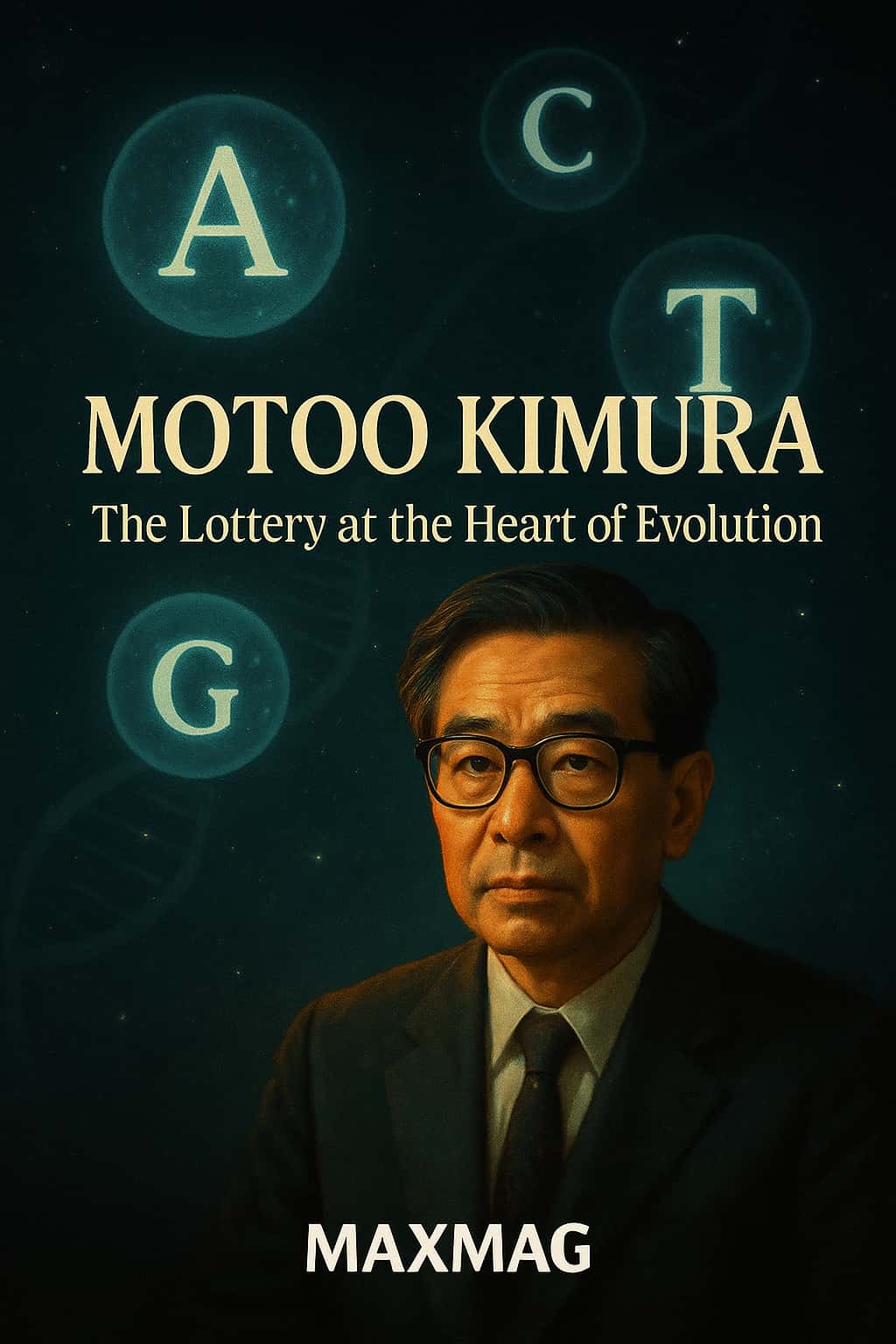
Later Years and Final Chapter of Motoo Kimura
Honours, illness and a difficult farewell
Recognition eventually caught up with Kimura. He received prestigious prizes in Japan and abroad, including the Darwin Medal of the Royal Society in 1992 and foreign membership in several academies. By then, his name had become shorthand in evolutionary circles: to talk about “Kimura’s theory” was simply to talk about a central reference point in molecular evolution.
Yet the last years described in any Motoo Kimura biography are tinged with sadness. He developed amyotrophic lateral sclerosis, the neurodegenerative disease often known in the United States as Lou Gehrig’s disease. As the illness progressed, his muscles weakened, but colleagues recall that his mind remained sharp and engaged. He continued to correspond, comment on papers and encourage younger researchers even as physical tasks became arduous.
On 13 November 1994, his seventieth birthday, Kimura died in Shizuoka after complications from a fall led to a cerebral haemorrhage. It was an abrupt end to a long decline, and it left the community of evolutionary geneticists with a sense of unfinished conversation – debates about adaptation and drift that would continue without one of their fiercest, most articulate participants.
Looking back on a life in probabilities
In later interviews and essays, Kimura sometimes reflected on his own path with characteristic dryness. He knew that the neutral theory of molecular evolution would never entirely settle the disputes it had opened up. But he took satisfaction in having shown, with as much clarity as the mathematics allowed, that genetic drift could not be treated as a minor footnote.
Seen from the vantage point of today’s genome-rich biology, the Motoo Kimura biography feels less like a tale of a lone rebel and more like a chapter in a longer story: the struggle to reconcile our intuitive preference for neat causal narratives with the messy, stochastic reality of molecular change.
The Lasting Legacy of Motoo Kimura biography
Why neutral theory still matters
Half a century after its birth, neutral theory remains a live topic in evolutionary biology. Few scientists now believe that all molecular changes are neutral, and many argue that adaptation plays a larger role in shaping genomes than Kimura envisioned. Yet even those critics typically accept that a substantial fraction of genetic variation is effectively neutral – and they still use neutral models as baselines.
That ongoing use is itself a central part of the Motoo Kimura legacy. Neutral theory has become, in practice, the “null model” of molecular evolution: the starting point from which more complex, selection-heavy stories must depart. In statistical terms, it is the benchmark that keeps our evolutionary narratives honest, forcing us to show that observed patterns really do require adaptationist explanations.
A bigger lesson about science and chance
The deeper message of the Motoo Kimura biography, however, is not just about DNA. It is about how science deals with randomness. Humans are natural storytellers; we like to think in terms of purpose, progress and design. Neutral theory reminds us that much of what happens – in genomes, in ecosystems, perhaps even in social life – emerges from the cumulative effect of small, random events that no one intended.
Understanding the Motoo Kimura biography helps us see modern science in a more nuanced way. Evolution is not a morality tale of the “fittest” triumphing at every turn; it is a dynamic interplay between selection and drift, between forces that sculpt and forces that shuffle. In that interplay, Kimura’s quiet insistence on the importance of chance continues to shape how researchers read genomes, interpret data and argue about the past. Neutral theory may be about randomness, but the life behind it was anything but random – it was a deliberate, often lonely push to expand what evolutionary theory is willing to admit.

